Analysis of Stewardship Model: Benefits and Challenges
VerifiedAdded on 2023/01/16
|10
|2288
|46
Report
AI Summary
This report provides a critical analysis of the Stewardship model, focusing on its potential benefits and challenges within an organizational context. The paper begins with an introduction to the Stewardship model, highlighting its key elements as defined by Block and Wilson, emphasizing empowerment, partnership, and service over self-interest. The discussion section delves into the advantages of adopting the model, such as equitable power distribution, fostering employee accountability, and promoting teamwork, using Telstra as a case study. It also examines the challenges that organizations face during implementation, including communication issues, resistance to change, and the need for a shift from traditional reward systems. The conclusion reiterates the model's advantages, while acknowledging the complexities of transitioning from hierarchical structures to a stewardship-based approach. The report underscores the importance of the Stewardship model for reshaping organizational structure and improving employee engagement.
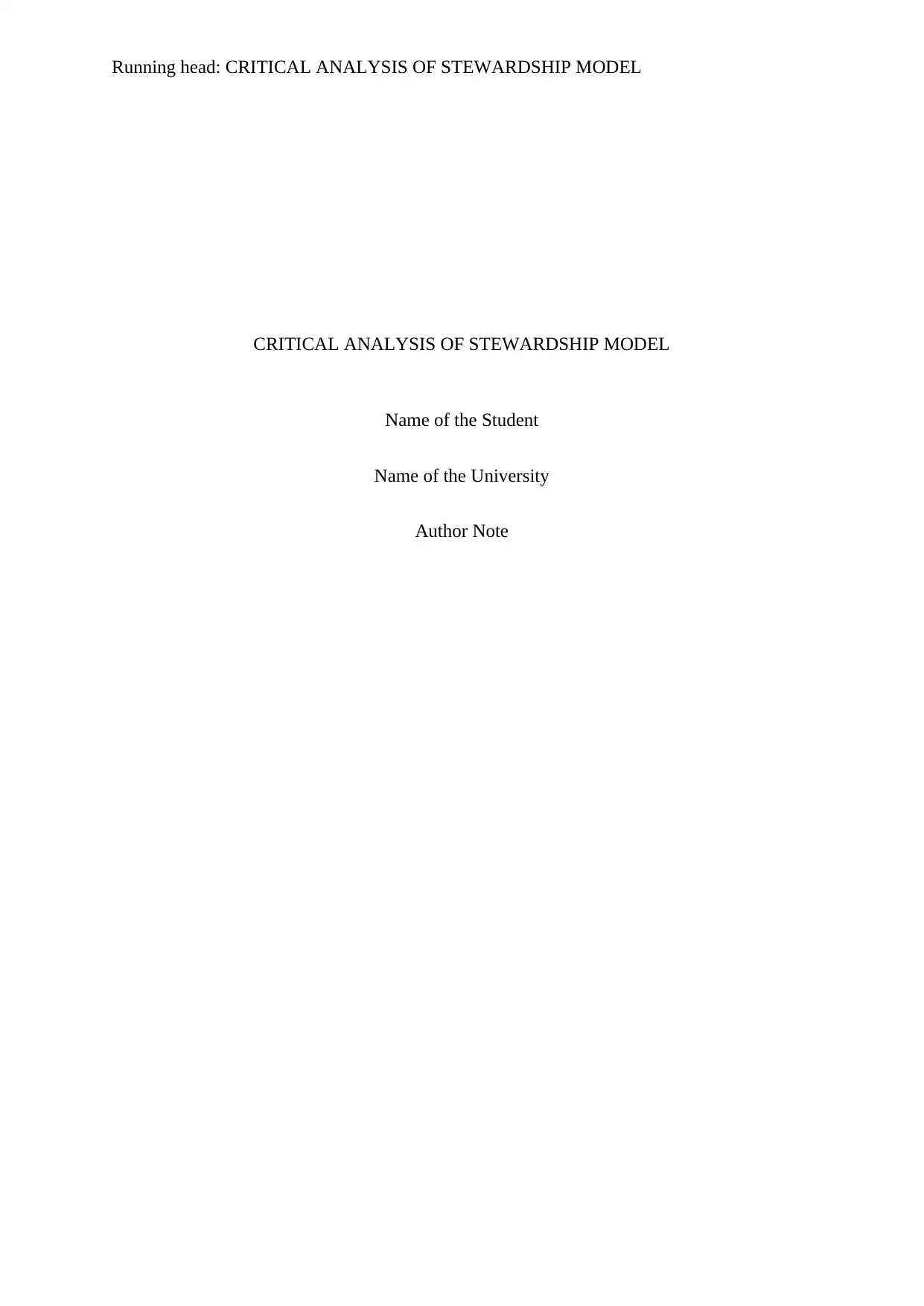
Running head: CRITICAL ANALYSIS OF STEWARDSHIP MODEL
CRITICAL ANALYSIS OF STEWARDSHIP MODEL
Name of the Student
Name of the University
Author Note
CRITICAL ANALYSIS OF STEWARDSHIP MODEL
Name of the Student
Name of the University
Author Note
Paraphrase This Document
Need a fresh take? Get an instant paraphrase of this document with our AI Paraphraser
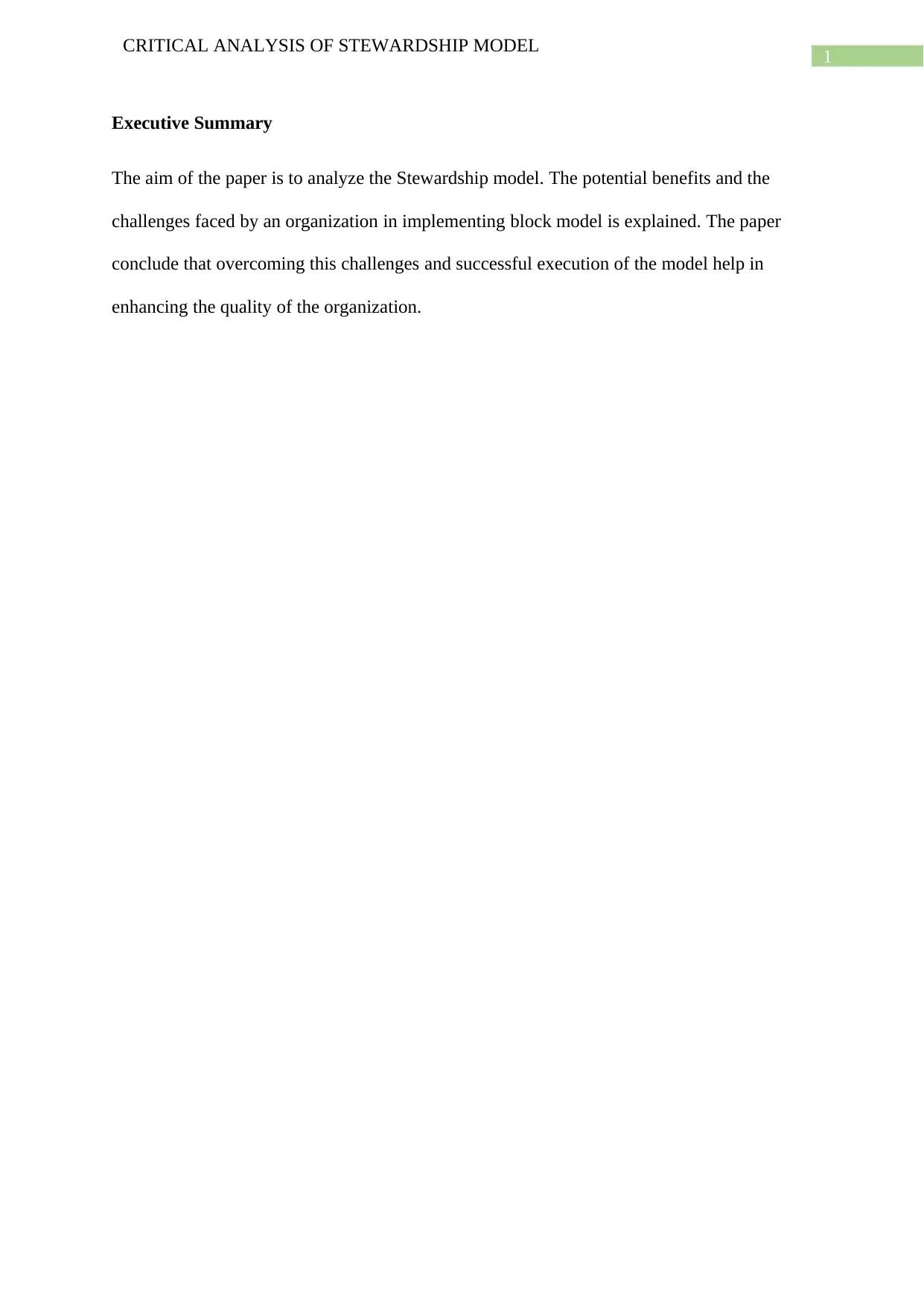
1
CRITICAL ANALYSIS OF STEWARDSHIP MODEL
Executive Summary
The aim of the paper is to analyze the Stewardship model. The potential benefits and the
challenges faced by an organization in implementing block model is explained. The paper
conclude that overcoming this challenges and successful execution of the model help in
enhancing the quality of the organization.
CRITICAL ANALYSIS OF STEWARDSHIP MODEL
Executive Summary
The aim of the paper is to analyze the Stewardship model. The potential benefits and the
challenges faced by an organization in implementing block model is explained. The paper
conclude that overcoming this challenges and successful execution of the model help in
enhancing the quality of the organization.
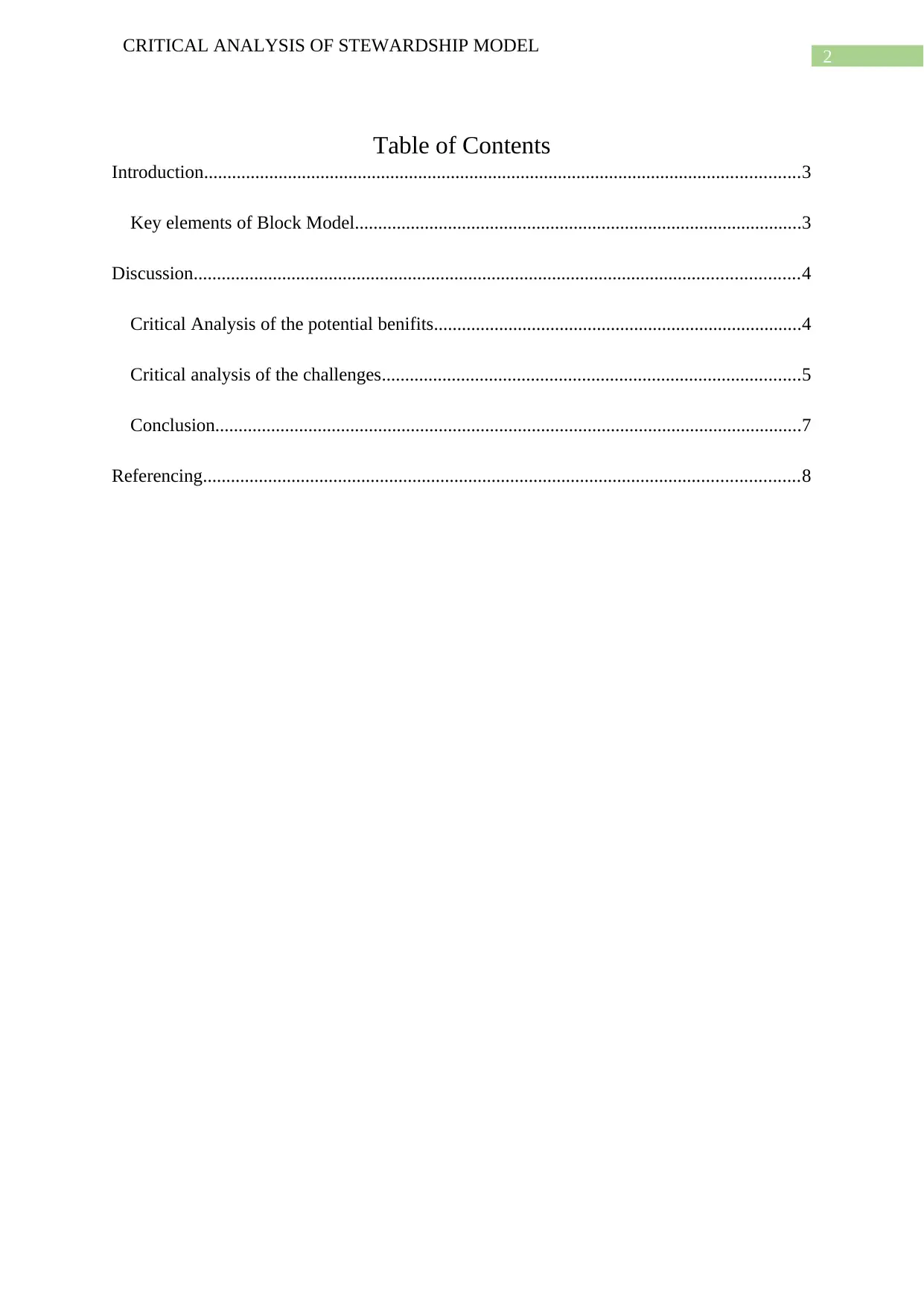
2
CRITICAL ANALYSIS OF STEWARDSHIP MODEL
Table of Contents
Introduction................................................................................................................................3
Key elements of Block Model................................................................................................3
Discussion..................................................................................................................................4
Critical Analysis of the potential benifits...............................................................................4
Critical analysis of the challenges..........................................................................................5
Conclusion..............................................................................................................................7
Referencing................................................................................................................................8
CRITICAL ANALYSIS OF STEWARDSHIP MODEL
Table of Contents
Introduction................................................................................................................................3
Key elements of Block Model................................................................................................3
Discussion..................................................................................................................................4
Critical Analysis of the potential benifits...............................................................................4
Critical analysis of the challenges..........................................................................................5
Conclusion..............................................................................................................................7
Referencing................................................................................................................................8
⊘ This is a preview!⊘
Do you want full access?
Subscribe today to unlock all pages.

Trusted by 1+ million students worldwide
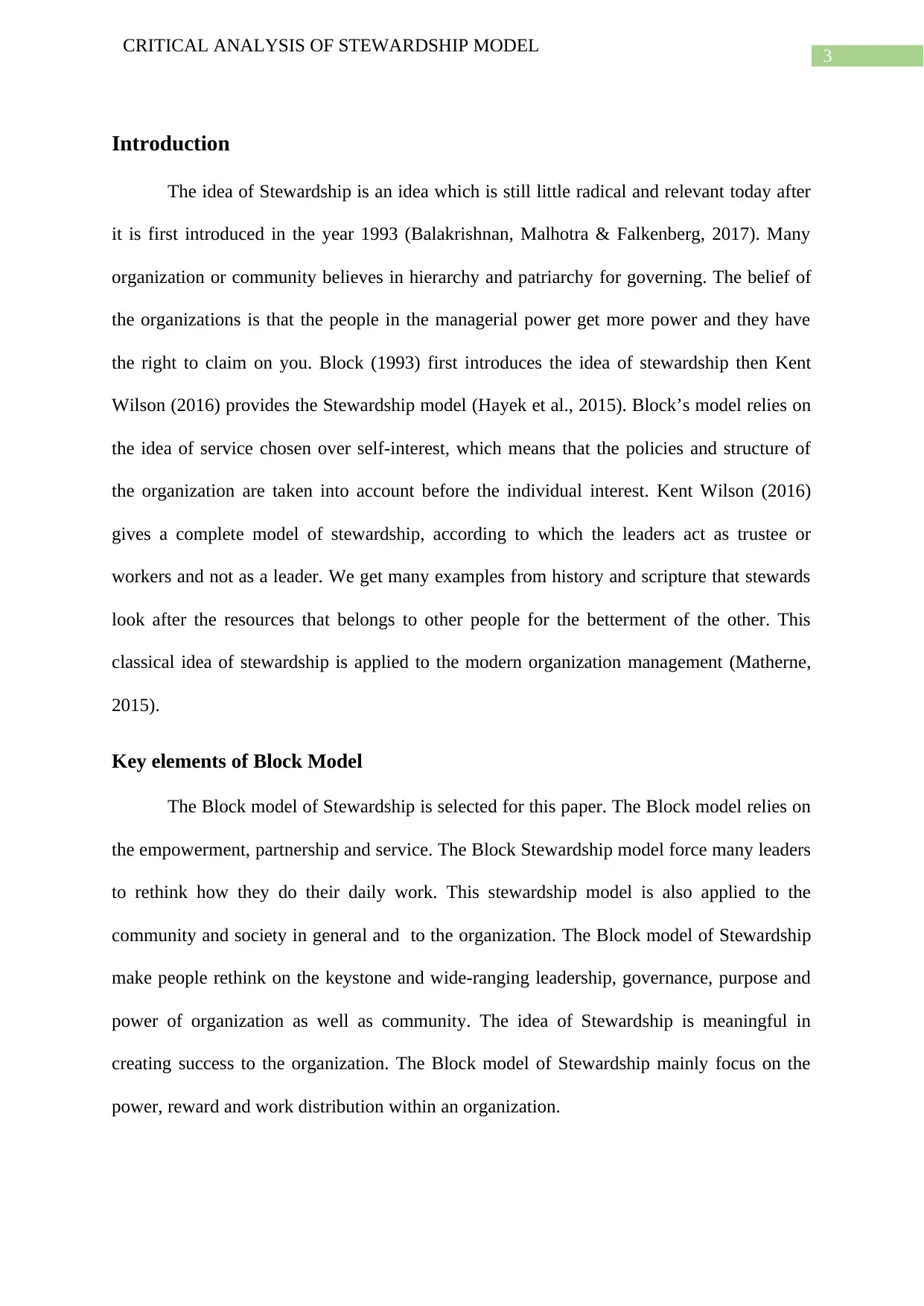
3
CRITICAL ANALYSIS OF STEWARDSHIP MODEL
Introduction
The idea of Stewardship is an idea which is still little radical and relevant today after
it is first introduced in the year 1993 (Balakrishnan, Malhotra & Falkenberg, 2017). Many
organization or community believes in hierarchy and patriarchy for governing. The belief of
the organizations is that the people in the managerial power get more power and they have
the right to claim on you. Block (1993) first introduces the idea of stewardship then Kent
Wilson (2016) provides the Stewardship model (Hayek et al., 2015). Block’s model relies on
the idea of service chosen over self-interest, which means that the policies and structure of
the organization are taken into account before the individual interest. Kent Wilson (2016)
gives a complete model of stewardship, according to which the leaders act as trustee or
workers and not as a leader. We get many examples from history and scripture that stewards
look after the resources that belongs to other people for the betterment of the other. This
classical idea of stewardship is applied to the modern organization management (Matherne,
2015).
Key elements of Block Model
The Block model of Stewardship is selected for this paper. The Block model relies on
the empowerment, partnership and service. The Block Stewardship model force many leaders
to rethink how they do their daily work. This stewardship model is also applied to the
community and society in general and to the organization. The Block model of Stewardship
make people rethink on the keystone and wide-ranging leadership, governance, purpose and
power of organization as well as community. The idea of Stewardship is meaningful in
creating success to the organization. The Block model of Stewardship mainly focus on the
power, reward and work distribution within an organization.
CRITICAL ANALYSIS OF STEWARDSHIP MODEL
Introduction
The idea of Stewardship is an idea which is still little radical and relevant today after
it is first introduced in the year 1993 (Balakrishnan, Malhotra & Falkenberg, 2017). Many
organization or community believes in hierarchy and patriarchy for governing. The belief of
the organizations is that the people in the managerial power get more power and they have
the right to claim on you. Block (1993) first introduces the idea of stewardship then Kent
Wilson (2016) provides the Stewardship model (Hayek et al., 2015). Block’s model relies on
the idea of service chosen over self-interest, which means that the policies and structure of
the organization are taken into account before the individual interest. Kent Wilson (2016)
gives a complete model of stewardship, according to which the leaders act as trustee or
workers and not as a leader. We get many examples from history and scripture that stewards
look after the resources that belongs to other people for the betterment of the other. This
classical idea of stewardship is applied to the modern organization management (Matherne,
2015).
Key elements of Block Model
The Block model of Stewardship is selected for this paper. The Block model relies on
the empowerment, partnership and service. The Block Stewardship model force many leaders
to rethink how they do their daily work. This stewardship model is also applied to the
community and society in general and to the organization. The Block model of Stewardship
make people rethink on the keystone and wide-ranging leadership, governance, purpose and
power of organization as well as community. The idea of Stewardship is meaningful in
creating success to the organization. The Block model of Stewardship mainly focus on the
power, reward and work distribution within an organization.
Paraphrase This Document
Need a fresh take? Get an instant paraphrase of this document with our AI Paraphraser
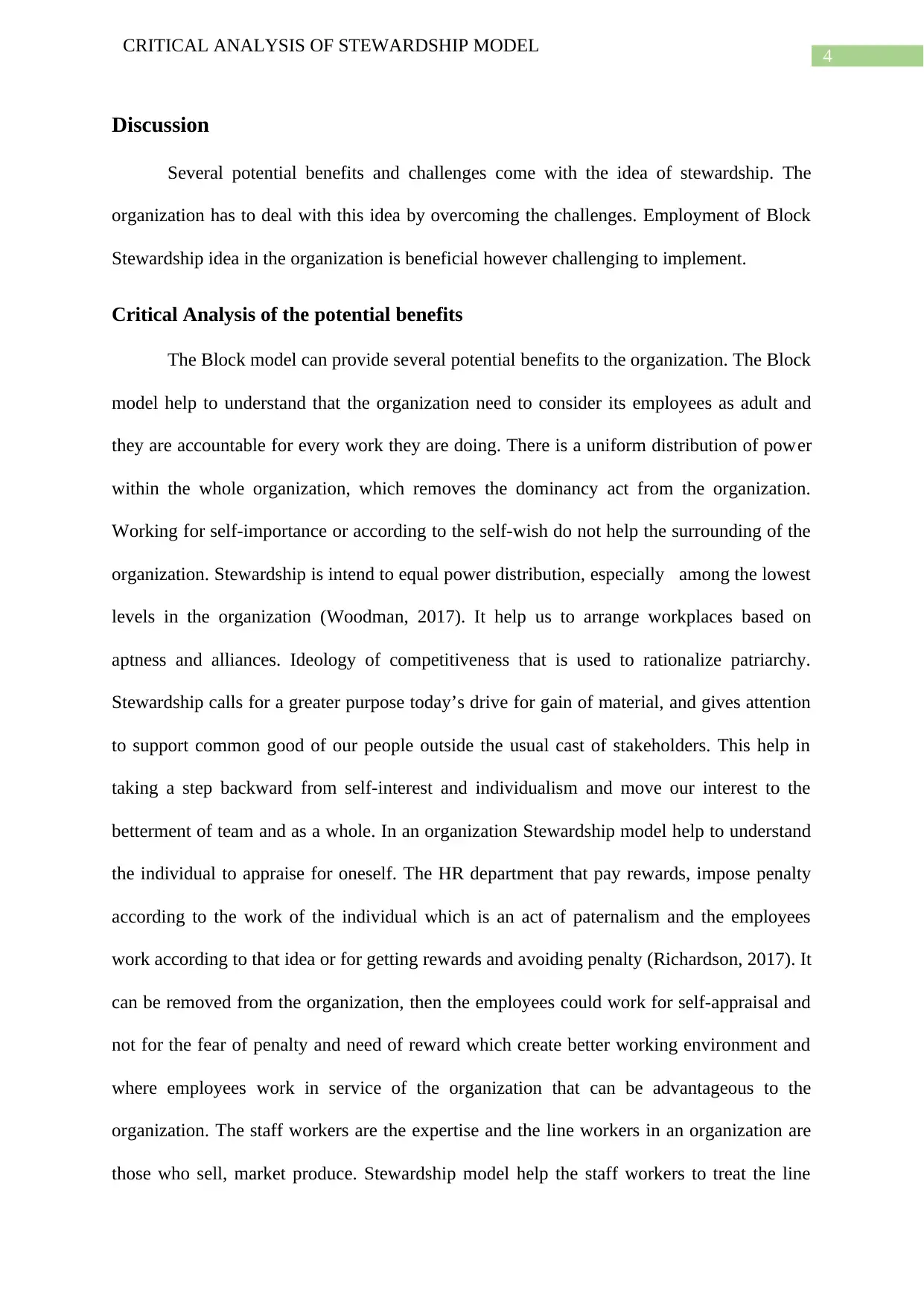
4
CRITICAL ANALYSIS OF STEWARDSHIP MODEL
Discussion
Several potential benefits and challenges come with the idea of stewardship. The
organization has to deal with this idea by overcoming the challenges. Employment of Block
Stewardship idea in the organization is beneficial however challenging to implement.
Critical Analysis of the potential benefits
The Block model can provide several potential benefits to the organization. The Block
model help to understand that the organization need to consider its employees as adult and
they are accountable for every work they are doing. There is a uniform distribution of power
within the whole organization, which removes the dominancy act from the organization.
Working for self-importance or according to the self-wish do not help the surrounding of the
organization. Stewardship is intend to equal power distribution, especially among the lowest
levels in the organization (Woodman, 2017). It help us to arrange workplaces based on
aptness and alliances. Ideology of competitiveness that is used to rationalize patriarchy.
Stewardship calls for a greater purpose today’s drive for gain of material, and gives attention
to support common good of our people outside the usual cast of stakeholders. This help in
taking a step backward from self-interest and individualism and move our interest to the
betterment of team and as a whole. In an organization Stewardship model help to understand
the individual to appraise for oneself. The HR department that pay rewards, impose penalty
according to the work of the individual which is an act of paternalism and the employees
work according to that idea or for getting rewards and avoiding penalty (Richardson, 2017). It
can be removed from the organization, then the employees could work for self-appraisal and
not for the fear of penalty and need of reward which create better working environment and
where employees work in service of the organization that can be advantageous to the
organization. The staff workers are the expertise and the line workers in an organization are
those who sell, market produce. Stewardship model help the staff workers to treat the line
CRITICAL ANALYSIS OF STEWARDSHIP MODEL
Discussion
Several potential benefits and challenges come with the idea of stewardship. The
organization has to deal with this idea by overcoming the challenges. Employment of Block
Stewardship idea in the organization is beneficial however challenging to implement.
Critical Analysis of the potential benefits
The Block model can provide several potential benefits to the organization. The Block
model help to understand that the organization need to consider its employees as adult and
they are accountable for every work they are doing. There is a uniform distribution of power
within the whole organization, which removes the dominancy act from the organization.
Working for self-importance or according to the self-wish do not help the surrounding of the
organization. Stewardship is intend to equal power distribution, especially among the lowest
levels in the organization (Woodman, 2017). It help us to arrange workplaces based on
aptness and alliances. Ideology of competitiveness that is used to rationalize patriarchy.
Stewardship calls for a greater purpose today’s drive for gain of material, and gives attention
to support common good of our people outside the usual cast of stakeholders. This help in
taking a step backward from self-interest and individualism and move our interest to the
betterment of team and as a whole. In an organization Stewardship model help to understand
the individual to appraise for oneself. The HR department that pay rewards, impose penalty
according to the work of the individual which is an act of paternalism and the employees
work according to that idea or for getting rewards and avoiding penalty (Richardson, 2017). It
can be removed from the organization, then the employees could work for self-appraisal and
not for the fear of penalty and need of reward which create better working environment and
where employees work in service of the organization that can be advantageous to the
organization. The staff workers are the expertise and the line workers in an organization are
those who sell, market produce. Stewardship model help the staff workers to treat the line
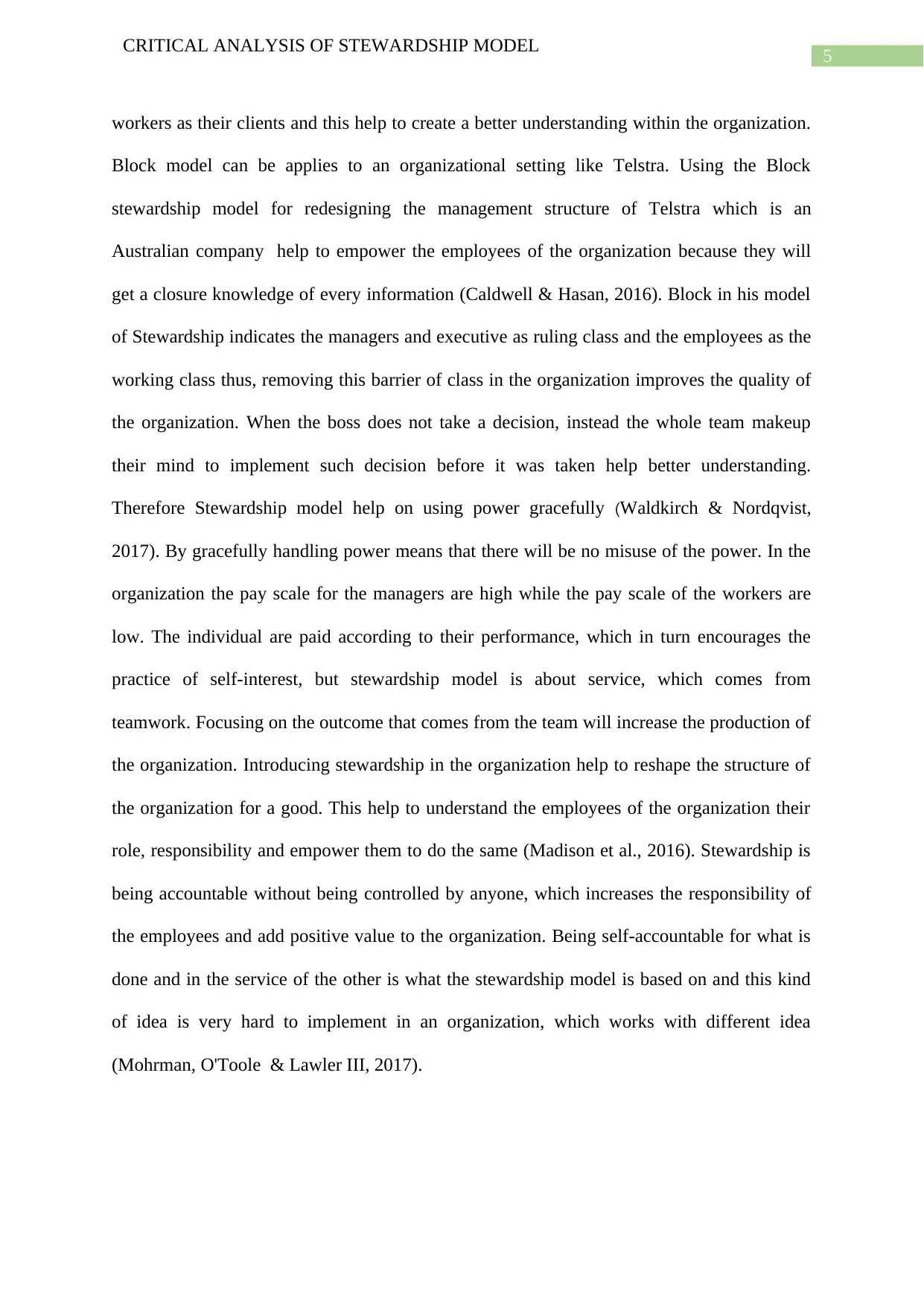
5
CRITICAL ANALYSIS OF STEWARDSHIP MODEL
workers as their clients and this help to create a better understanding within the organization.
Block model can be applies to an organizational setting like Telstra. Using the Block
stewardship model for redesigning the management structure of Telstra which is an
Australian company help to empower the employees of the organization because they will
get a closure knowledge of every information (Caldwell & Hasan, 2016). Block in his model
of Stewardship indicates the managers and executive as ruling class and the employees as the
working class thus, removing this barrier of class in the organization improves the quality of
the organization. When the boss does not take a decision, instead the whole team makeup
their mind to implement such decision before it was taken help better understanding.
Therefore Stewardship model help on using power gracefully (Waldkirch & Nordqvist,
2017). By gracefully handling power means that there will be no misuse of the power. In the
organization the pay scale for the managers are high while the pay scale of the workers are
low. The individual are paid according to their performance, which in turn encourages the
practice of self-interest, but stewardship model is about service, which comes from
teamwork. Focusing on the outcome that comes from the team will increase the production of
the organization. Introducing stewardship in the organization help to reshape the structure of
the organization for a good. This help to understand the employees of the organization their
role, responsibility and empower them to do the same (Madison et al., 2016). Stewardship is
being accountable without being controlled by anyone, which increases the responsibility of
the employees and add positive value to the organization. Being self-accountable for what is
done and in the service of the other is what the stewardship model is based on and this kind
of idea is very hard to implement in an organization, which works with different idea
(Mohrman, O'Toole & Lawler III, 2017).
CRITICAL ANALYSIS OF STEWARDSHIP MODEL
workers as their clients and this help to create a better understanding within the organization.
Block model can be applies to an organizational setting like Telstra. Using the Block
stewardship model for redesigning the management structure of Telstra which is an
Australian company help to empower the employees of the organization because they will
get a closure knowledge of every information (Caldwell & Hasan, 2016). Block in his model
of Stewardship indicates the managers and executive as ruling class and the employees as the
working class thus, removing this barrier of class in the organization improves the quality of
the organization. When the boss does not take a decision, instead the whole team makeup
their mind to implement such decision before it was taken help better understanding.
Therefore Stewardship model help on using power gracefully (Waldkirch & Nordqvist,
2017). By gracefully handling power means that there will be no misuse of the power. In the
organization the pay scale for the managers are high while the pay scale of the workers are
low. The individual are paid according to their performance, which in turn encourages the
practice of self-interest, but stewardship model is about service, which comes from
teamwork. Focusing on the outcome that comes from the team will increase the production of
the organization. Introducing stewardship in the organization help to reshape the structure of
the organization for a good. This help to understand the employees of the organization their
role, responsibility and empower them to do the same (Madison et al., 2016). Stewardship is
being accountable without being controlled by anyone, which increases the responsibility of
the employees and add positive value to the organization. Being self-accountable for what is
done and in the service of the other is what the stewardship model is based on and this kind
of idea is very hard to implement in an organization, which works with different idea
(Mohrman, O'Toole & Lawler III, 2017).
⊘ This is a preview!⊘
Do you want full access?
Subscribe today to unlock all pages.

Trusted by 1+ million students worldwide
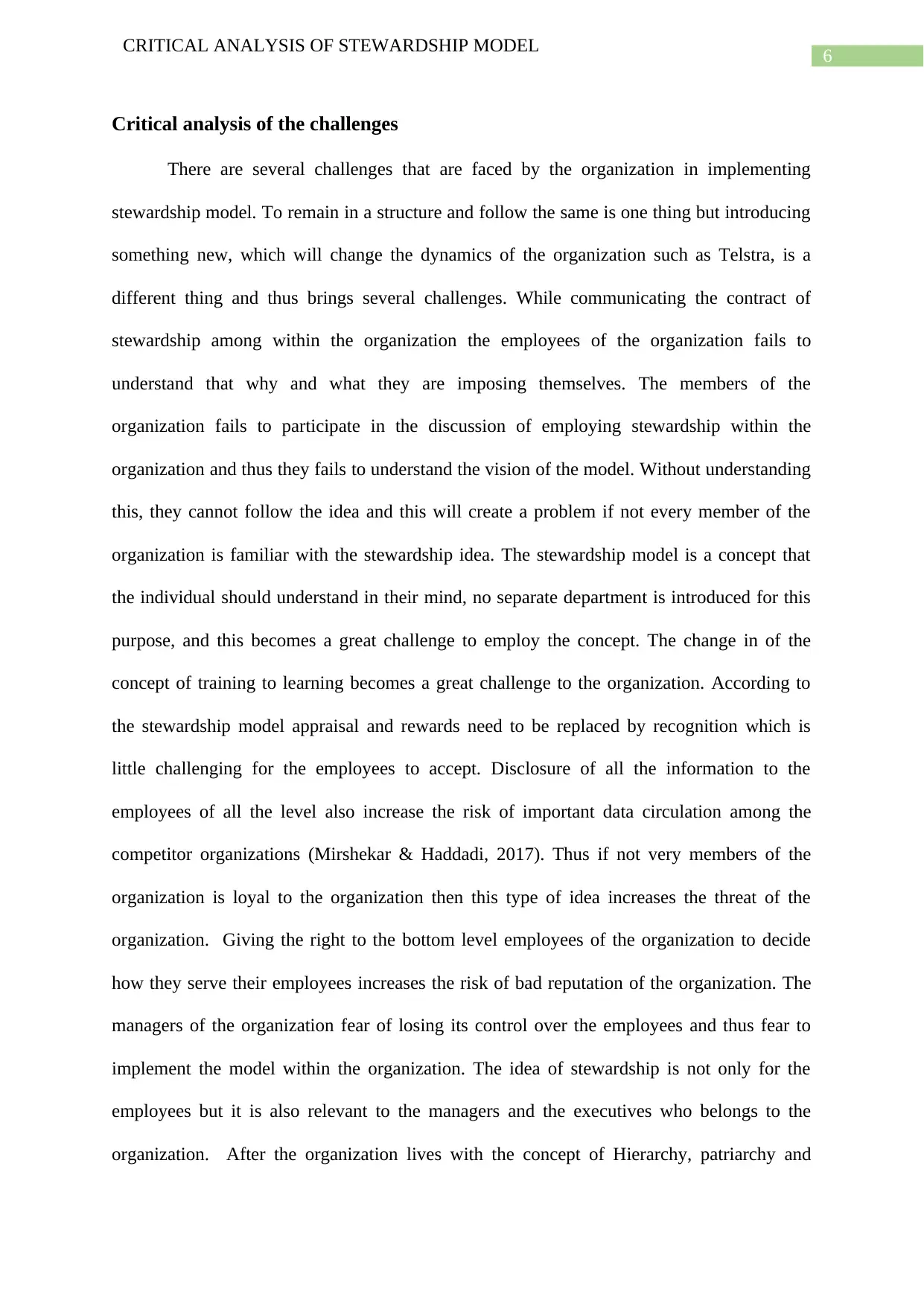
6
CRITICAL ANALYSIS OF STEWARDSHIP MODEL
Critical analysis of the challenges
There are several challenges that are faced by the organization in implementing
stewardship model. To remain in a structure and follow the same is one thing but introducing
something new, which will change the dynamics of the organization such as Telstra, is a
different thing and thus brings several challenges. While communicating the contract of
stewardship among within the organization the employees of the organization fails to
understand that why and what they are imposing themselves. The members of the
organization fails to participate in the discussion of employing stewardship within the
organization and thus they fails to understand the vision of the model. Without understanding
this, they cannot follow the idea and this will create a problem if not every member of the
organization is familiar with the stewardship idea. The stewardship model is a concept that
the individual should understand in their mind, no separate department is introduced for this
purpose, and this becomes a great challenge to employ the concept. The change in of the
concept of training to learning becomes a great challenge to the organization. According to
the stewardship model appraisal and rewards need to be replaced by recognition which is
little challenging for the employees to accept. Disclosure of all the information to the
employees of all the level also increase the risk of important data circulation among the
competitor organizations (Mirshekar & Haddadi, 2017). Thus if not very members of the
organization is loyal to the organization then this type of idea increases the threat of the
organization. Giving the right to the bottom level employees of the organization to decide
how they serve their employees increases the risk of bad reputation of the organization. The
managers of the organization fear of losing its control over the employees and thus fear to
implement the model within the organization. The idea of stewardship is not only for the
employees but it is also relevant to the managers and the executives who belongs to the
organization. After the organization lives with the concept of Hierarchy, patriarchy and
CRITICAL ANALYSIS OF STEWARDSHIP MODEL
Critical analysis of the challenges
There are several challenges that are faced by the organization in implementing
stewardship model. To remain in a structure and follow the same is one thing but introducing
something new, which will change the dynamics of the organization such as Telstra, is a
different thing and thus brings several challenges. While communicating the contract of
stewardship among within the organization the employees of the organization fails to
understand that why and what they are imposing themselves. The members of the
organization fails to participate in the discussion of employing stewardship within the
organization and thus they fails to understand the vision of the model. Without understanding
this, they cannot follow the idea and this will create a problem if not every member of the
organization is familiar with the stewardship idea. The stewardship model is a concept that
the individual should understand in their mind, no separate department is introduced for this
purpose, and this becomes a great challenge to employ the concept. The change in of the
concept of training to learning becomes a great challenge to the organization. According to
the stewardship model appraisal and rewards need to be replaced by recognition which is
little challenging for the employees to accept. Disclosure of all the information to the
employees of all the level also increase the risk of important data circulation among the
competitor organizations (Mirshekar & Haddadi, 2017). Thus if not very members of the
organization is loyal to the organization then this type of idea increases the threat of the
organization. Giving the right to the bottom level employees of the organization to decide
how they serve their employees increases the risk of bad reputation of the organization. The
managers of the organization fear of losing its control over the employees and thus fear to
implement the model within the organization. The idea of stewardship is not only for the
employees but it is also relevant to the managers and the executives who belongs to the
organization. After the organization lives with the concept of Hierarchy, patriarchy and
Paraphrase This Document
Need a fresh take? Get an instant paraphrase of this document with our AI Paraphraser
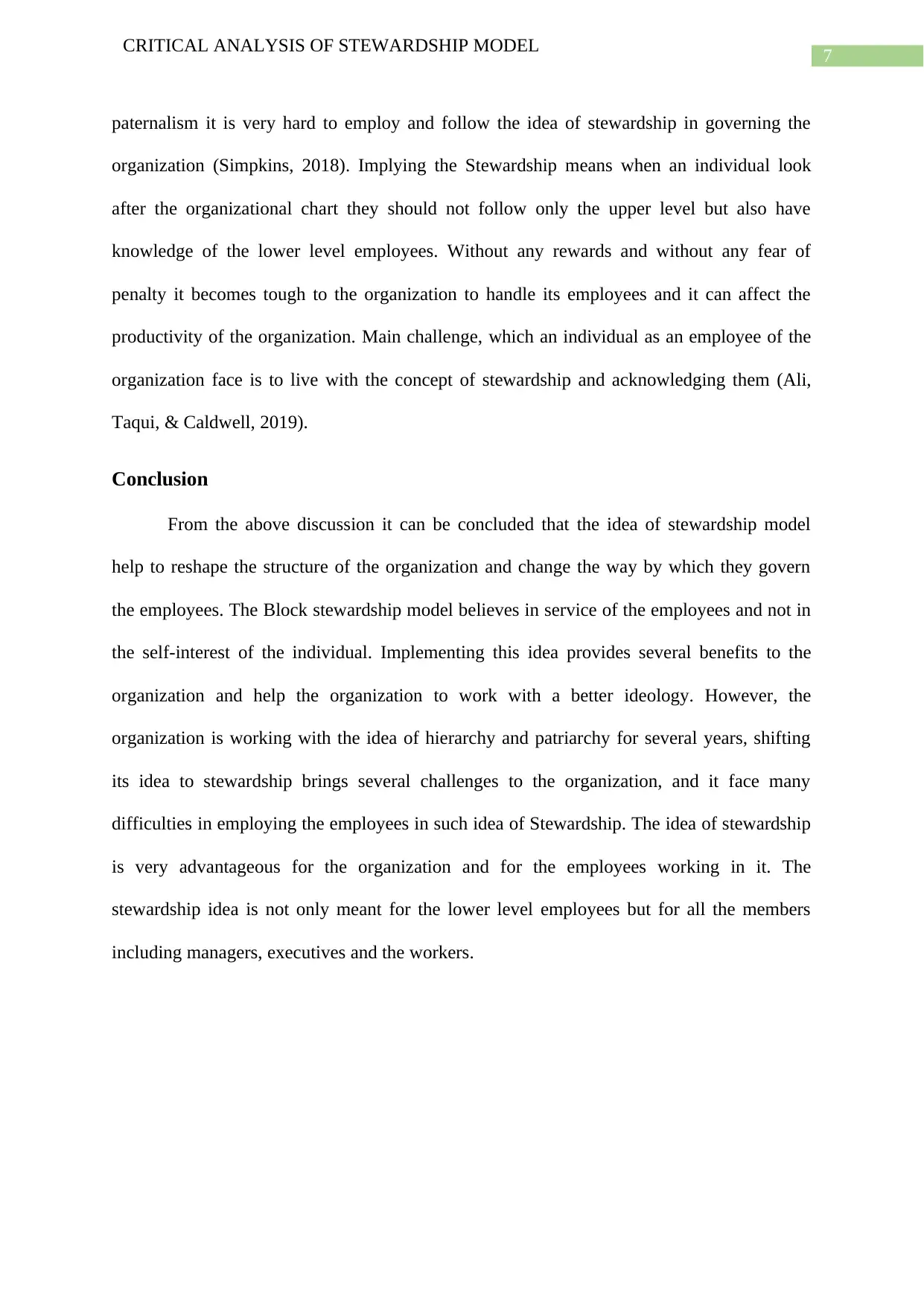
7
CRITICAL ANALYSIS OF STEWARDSHIP MODEL
paternalism it is very hard to employ and follow the idea of stewardship in governing the
organization (Simpkins, 2018). Implying the Stewardship means when an individual look
after the organizational chart they should not follow only the upper level but also have
knowledge of the lower level employees. Without any rewards and without any fear of
penalty it becomes tough to the organization to handle its employees and it can affect the
productivity of the organization. Main challenge, which an individual as an employee of the
organization face is to live with the concept of stewardship and acknowledging them (Ali,
Taqui, & Caldwell, 2019).
Conclusion
From the above discussion it can be concluded that the idea of stewardship model
help to reshape the structure of the organization and change the way by which they govern
the employees. The Block stewardship model believes in service of the employees and not in
the self-interest of the individual. Implementing this idea provides several benefits to the
organization and help the organization to work with a better ideology. However, the
organization is working with the idea of hierarchy and patriarchy for several years, shifting
its idea to stewardship brings several challenges to the organization, and it face many
difficulties in employing the employees in such idea of Stewardship. The idea of stewardship
is very advantageous for the organization and for the employees working in it. The
stewardship idea is not only meant for the lower level employees but for all the members
including managers, executives and the workers.
CRITICAL ANALYSIS OF STEWARDSHIP MODEL
paternalism it is very hard to employ and follow the idea of stewardship in governing the
organization (Simpkins, 2018). Implying the Stewardship means when an individual look
after the organizational chart they should not follow only the upper level but also have
knowledge of the lower level employees. Without any rewards and without any fear of
penalty it becomes tough to the organization to handle its employees and it can affect the
productivity of the organization. Main challenge, which an individual as an employee of the
organization face is to live with the concept of stewardship and acknowledging them (Ali,
Taqui, & Caldwell, 2019).
Conclusion
From the above discussion it can be concluded that the idea of stewardship model
help to reshape the structure of the organization and change the way by which they govern
the employees. The Block stewardship model believes in service of the employees and not in
the self-interest of the individual. Implementing this idea provides several benefits to the
organization and help the organization to work with a better ideology. However, the
organization is working with the idea of hierarchy and patriarchy for several years, shifting
its idea to stewardship brings several challenges to the organization, and it face many
difficulties in employing the employees in such idea of Stewardship. The idea of stewardship
is very advantageous for the organization and for the employees working in it. The
stewardship idea is not only meant for the lower level employees but for all the members
including managers, executives and the workers.
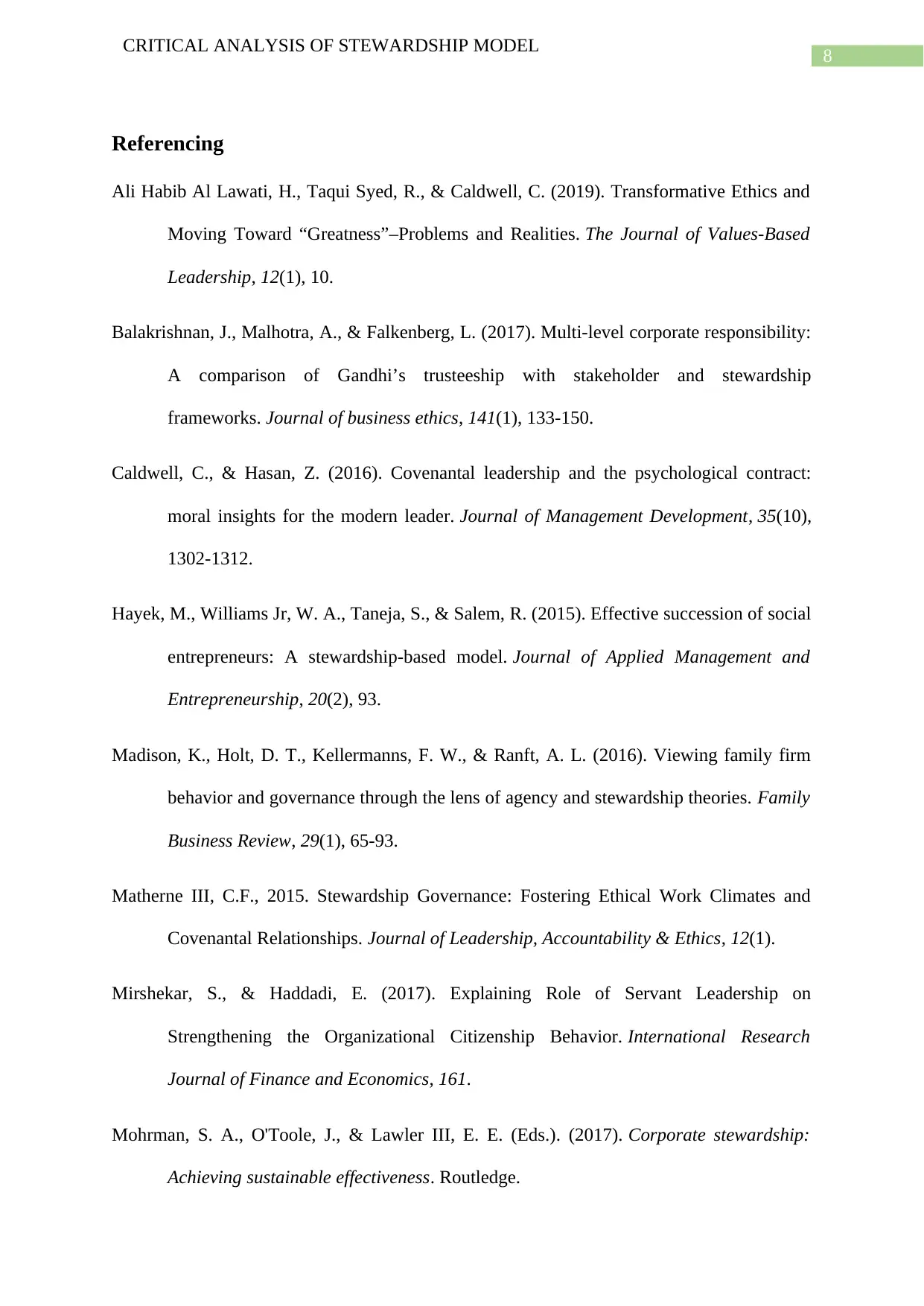
8
CRITICAL ANALYSIS OF STEWARDSHIP MODEL
Referencing
Ali Habib Al Lawati, H., Taqui Syed, R., & Caldwell, C. (2019). Transformative Ethics and
Moving Toward “Greatness”–Problems and Realities. The Journal of Values-Based
Leadership, 12(1), 10.
Balakrishnan, J., Malhotra, A., & Falkenberg, L. (2017). Multi-level corporate responsibility:
A comparison of Gandhi’s trusteeship with stakeholder and stewardship
frameworks. Journal of business ethics, 141(1), 133-150.
Caldwell, C., & Hasan, Z. (2016). Covenantal leadership and the psychological contract:
moral insights for the modern leader. Journal of Management Development, 35(10),
1302-1312.
Hayek, M., Williams Jr, W. A., Taneja, S., & Salem, R. (2015). Effective succession of social
entrepreneurs: A stewardship-based model. Journal of Applied Management and
Entrepreneurship, 20(2), 93.
Madison, K., Holt, D. T., Kellermanns, F. W., & Ranft, A. L. (2016). Viewing family firm
behavior and governance through the lens of agency and stewardship theories. Family
Business Review, 29(1), 65-93.
Matherne III, C.F., 2015. Stewardship Governance: Fostering Ethical Work Climates and
Covenantal Relationships. Journal of Leadership, Accountability & Ethics, 12(1).
Mirshekar, S., & Haddadi, E. (2017). Explaining Role of Servant Leadership on
Strengthening the Organizational Citizenship Behavior. International Research
Journal of Finance and Economics, 161.
Mohrman, S. A., O'Toole, J., & Lawler III, E. E. (Eds.). (2017). Corporate stewardship:
Achieving sustainable effectiveness. Routledge.
CRITICAL ANALYSIS OF STEWARDSHIP MODEL
Referencing
Ali Habib Al Lawati, H., Taqui Syed, R., & Caldwell, C. (2019). Transformative Ethics and
Moving Toward “Greatness”–Problems and Realities. The Journal of Values-Based
Leadership, 12(1), 10.
Balakrishnan, J., Malhotra, A., & Falkenberg, L. (2017). Multi-level corporate responsibility:
A comparison of Gandhi’s trusteeship with stakeholder and stewardship
frameworks. Journal of business ethics, 141(1), 133-150.
Caldwell, C., & Hasan, Z. (2016). Covenantal leadership and the psychological contract:
moral insights for the modern leader. Journal of Management Development, 35(10),
1302-1312.
Hayek, M., Williams Jr, W. A., Taneja, S., & Salem, R. (2015). Effective succession of social
entrepreneurs: A stewardship-based model. Journal of Applied Management and
Entrepreneurship, 20(2), 93.
Madison, K., Holt, D. T., Kellermanns, F. W., & Ranft, A. L. (2016). Viewing family firm
behavior and governance through the lens of agency and stewardship theories. Family
Business Review, 29(1), 65-93.
Matherne III, C.F., 2015. Stewardship Governance: Fostering Ethical Work Climates and
Covenantal Relationships. Journal of Leadership, Accountability & Ethics, 12(1).
Mirshekar, S., & Haddadi, E. (2017). Explaining Role of Servant Leadership on
Strengthening the Organizational Citizenship Behavior. International Research
Journal of Finance and Economics, 161.
Mohrman, S. A., O'Toole, J., & Lawler III, E. E. (Eds.). (2017). Corporate stewardship:
Achieving sustainable effectiveness. Routledge.
⊘ This is a preview!⊘
Do you want full access?
Subscribe today to unlock all pages.

Trusted by 1+ million students worldwide
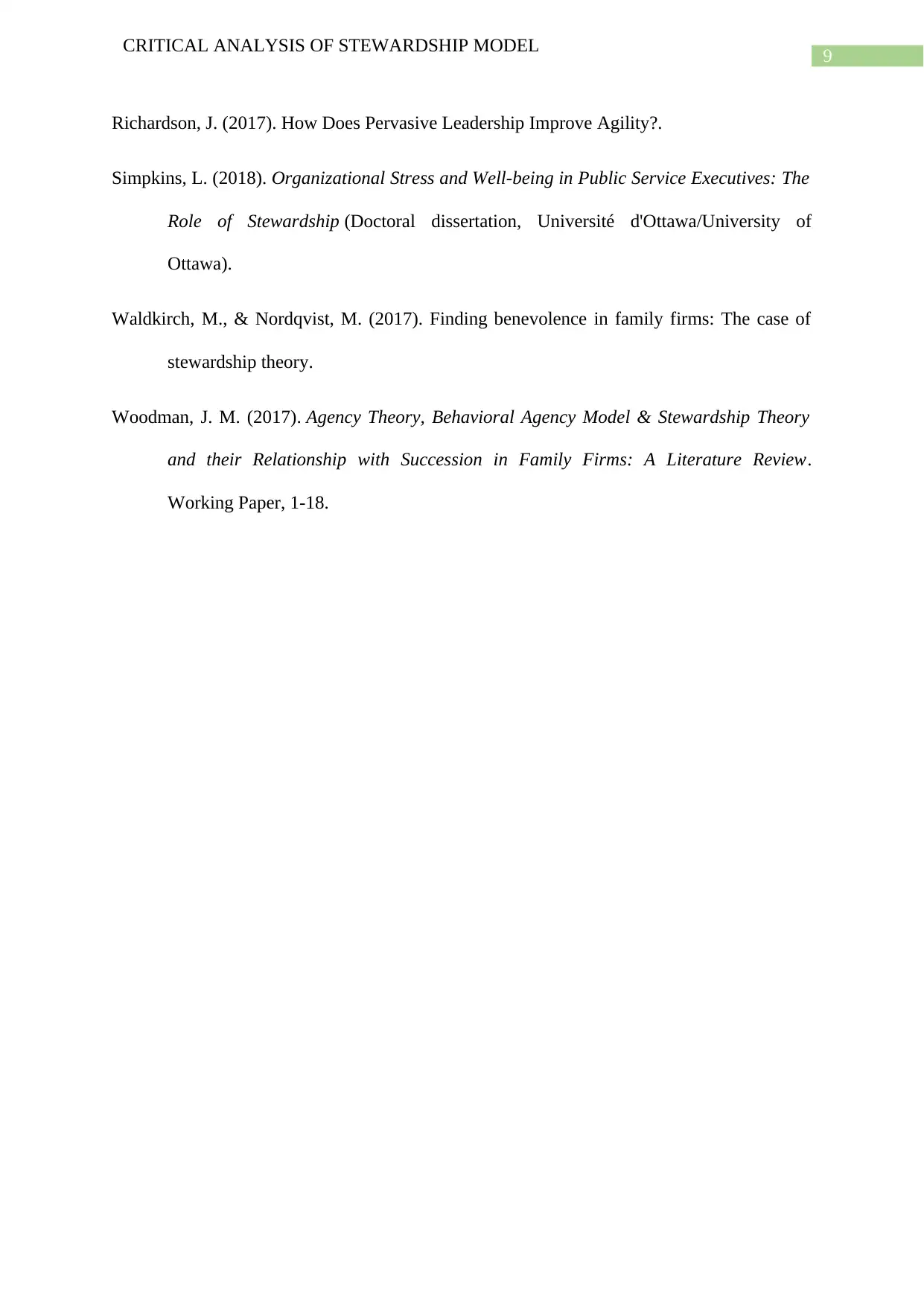
9
CRITICAL ANALYSIS OF STEWARDSHIP MODEL
Richardson, J. (2017). How Does Pervasive Leadership Improve Agility?.
Simpkins, L. (2018). Organizational Stress and Well-being in Public Service Executives: The
Role of Stewardship (Doctoral dissertation, Université d'Ottawa/University of
Ottawa).
Waldkirch, M., & Nordqvist, M. (2017). Finding benevolence in family firms: The case of
stewardship theory.
Woodman, J. M. (2017). Agency Theory, Behavioral Agency Model & Stewardship Theory
and their Relationship with Succession in Family Firms: A Literature Review.
Working Paper, 1-18.
CRITICAL ANALYSIS OF STEWARDSHIP MODEL
Richardson, J. (2017). How Does Pervasive Leadership Improve Agility?.
Simpkins, L. (2018). Organizational Stress and Well-being in Public Service Executives: The
Role of Stewardship (Doctoral dissertation, Université d'Ottawa/University of
Ottawa).
Waldkirch, M., & Nordqvist, M. (2017). Finding benevolence in family firms: The case of
stewardship theory.
Woodman, J. M. (2017). Agency Theory, Behavioral Agency Model & Stewardship Theory
and their Relationship with Succession in Family Firms: A Literature Review.
Working Paper, 1-18.
1 out of 10
Related Documents
Your All-in-One AI-Powered Toolkit for Academic Success.
+13062052269
info@desklib.com
Available 24*7 on WhatsApp / Email
![[object Object]](/_next/static/media/star-bottom.7253800d.svg)
Unlock your academic potential
Copyright © 2020–2025 A2Z Services. All Rights Reserved. Developed and managed by ZUCOL.





